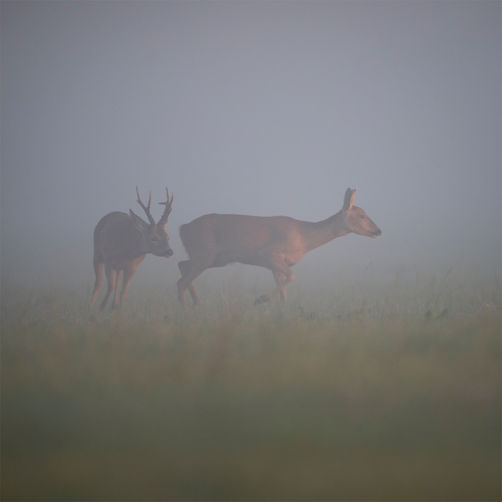About Deer
August
Key behaviours / activities to look out for this month are:
Adult males are especially active during the first part of the month
Bucks and does regularly seen together (often for days at a time), during the rut
Fawns more regularly seen with their mother
The start of August is the most reliable time to witness the roe deer's rut.
Just before we discuss photographing the rut, it's worth clarifying a couple of points so we can be accurate in our descriptions of the deer's behaviour.
The word 'rutting', as applied to deer, means 'engaging in the rut', and, 'the rut', is defined to be the deer's breeding season.
So, a male courting an amorous doe can accurately described as 'rutting', just as two males fighting over territory (which has a reproductive purpose) can be equally as accurately described as 'rutting'.
The reason I've mentioned that is because many seasoned nature watchers and photographers only use the term 'rutting' in relation to two deer fighting, not knowing that it can be equally applied to an in season (or pre-oestrus) female seeking the attention of a virile buck.
Recommended reading: If you would like to know more about the deer's mating behaviour, you may like to have a look at the articles in the Deer Information section called, "Roe deer mating behaviour and the rut, part 1" and "Roe deer mating behaviour and the rut, part 2". You will find plenty of detail in those articles.
Notwithstanding the fact that roebucks do not emit bellowing roars like, for example red deer do to advertise their presence to all and sundry, photographing the mating behaviour of roe deer is no easy task.
Although this is the time of year when roe deer are easily the most approachable, they are still wary of people.
As usual, early mornings and late evenings are the most reliable times to see them courting, but they will rut at any time of the day.
When it comes to positioning yourself so you can see them going through the whole courting and mating process, be aware that the enamored pair can turn up anywhere within the range.
To make a photograph of them actually mating, it's worth remembering that the coupling will only take place once the doe is properly in season and is comfortable with physical contact with the buck.
But before this happens, the doe will lead her buck on a merry dance, sometimes round in circles. And in the images shown above, you can see a short sequence of a female doing exaclty that! These paths are known as doe-rings, which are sometimes in a figure-of-eight-shape.
If you want to maximise your chances of witnessing the rut and to photograph the deer mating, I would strongly suggest you read the two articles that I mentioned above ("Roe deer mating behaviour and the rut, part 1" and "Roe deer mating behaviour and the rut, part 2").
If you do, your field craft will improve, enabling you to 'read the signs' reliably predicting their deer's behaviour, which I believe, can make a big difference to your success rate.
After a parental female has passed through oestrus, she will quickly lose interest in the buck and will immediately place more attention on her fawns once again.
The youngsters would have been periodically following their mum around the home range any time from late June onwards, but from now, you will be able to see them far more frequently, as they become more wide ranging in their movements.













